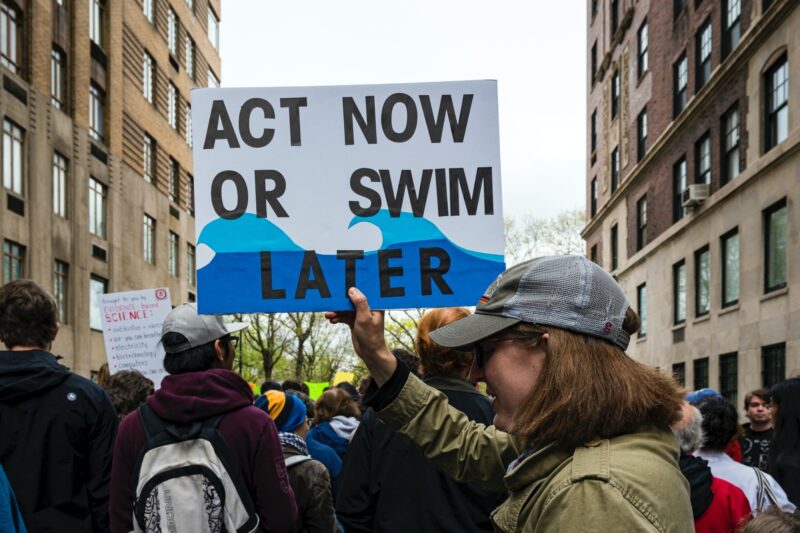A Green New Deal in the United States – fantasy or necessity?
The Green New Deal (GND) is currently only in the form of a “resolution” introduced by Representative Alexandria Ocasio-Cortez and Senator Ed Markey; any actual legislation that results from the resolution will be taken up by the respective chambers of Congress – and likely will not be done as a whole package. Having said that, the GND is a rare example of proposing how to tackle a societal-scale set of challenges not by looking at individual components but by presenting a vision for the whole system.
Share

Too often climate change conversations are isolated from a broad swathe of other issues that also are important for society as a whole. The key to systemic sustainable thinking is the realization that everything is connected, not only in natural ecosystems, but increasingly in our coupled human societal and economic systems as well.
The Green New Deal, introduced by Representative Alexandria Ocasio-Cortez and Senator Ed Markey, is a rare example of proposing how to tackle a societal-scale set of challenges not by looking at individual components but by presenting a vision for the whole system.
If we pick out individual proposals made in the resolution brought by Ocasio-Cortez and Markey, parts of which have been circulating for many years, they have strong support among much of the US public. Are there really many people against building resiliency to natural disasters, improving the efficiency with which energy is used, spurring job growth, upgrading aging infrastructure, continuing to ensure clean air and water, working collaboratively to solve problems, supporting family farmers, improving transportation systems and restoring and protecting threatened ecosystems?
Legitimate questions can be asked as to whether the time scale of the proposed initiatives is too ambitious, but that is where legislators should be in dialogue with constituents, stakeholders and experts in various sectors to determine strengths, weaknesses and opportunities of the GND. If that means a target to reach a carbon-dioxide emissions-free society by 2030 has to be delayed by a decade, at least the discussion is launched and pathways to get there can be defined.
On the other hand, the US is still a signatory to the Paris Agreement, and much of the broad outline contained in the GND would help move the US toward that commitment. The Paris Agreement requires nations of the world to hold “the increase in the global average temperature to well below 2°C above pre-industrial levels and pursuing efforts to limit the temperature increase to 1.5°C above pre-industrial levels, recognizing that this would significantly reduce the risks and impacts of climate change.” A robust feature of energy system transformation pathways that are compatible with the Paris Agreement is that there be a rapid increase in implementation of renewable and emission-free energy sources across all sectors of the economy. The implication of this transformation is that fossil fuel energy sources will have only a short future globally.
It is increasingly clear that climate change impacts are not only a concern for some undefined distant future, but are being felt now. While many governments around the world are moving slowly toward meeting their Paris Agreement targets, many others, including the US, are not. The Climate Action Tracker ranks US efforts as being “critically insufficient,” the lowest ranking category. Even the pledges made by the Obama administration were “insufficient” in terms of the Paris Agreement target. It is no wonder that our children are on the streets protesting about my generation’s lack of action in addressing a challenge that they will have to deal with as adults. This month at least one million people took part in events in over one hundred countries supporting action on climate change. And it is not as though there are no alternatives, as is recognized by the younger generation.
As one example, there has been a great deal of criticism and skepticism in the US about the renewable energy future proposed in the GND resolution, which as a matter of fact makes few concrete proposals but rather sets broad goals. However, we can look back several years to a report by the National Renewable Energy Lab (NREL) in a Renewable Electricity Futures Study published in 2012. In that study scenarios of up to 90% renewable electricity were studied, with the broad conclusion that there were no fundamental roadblocks to achieving this goal by 2050. In the decade that has passed since the data upon which that study was based, the cost of solar photovoltaics and of wind have decreased by two-thirds and are expected to drop nearly as much again in the next decade. Increasingly, the cheapest options for new electricity capacity are solar PV and wind, even if the additional costs of storage are included.
Researchers from the International Energy Agency, Greenpeace, Stanford, and from Universities in Australia have looked not only into the potential for transitioning to renewable electricity, but also looked at industrial energy use, building energy consumption and transportation. In their most ambitious cases they found that it would be possible to achieve the goal of 100% renewables and no carbon dioxide emissions by 2050. Experts have been repeatedly surprised at how much can be achieved with renewables, and at costs that are comparable to or less than energy costs today. In the Australian and Stanford scenarios they also analyzed the impact on energy-sector jobs up to 2030 and found a large net gain throughout the time period, as might be expected for a massive infrastructure transformation project. This is precisely part of what is promised, and promising, in the GND.
Examples of fast transformations are useful to look at as models from which the US can learn. Norway has gone from a near-zero sales volumes of electric vehicles a few years ago to over 30% of all new vehicle sales in 2018 (and nearly 50% if all plug-in vehicles are counted), with the trend still increasing. In Australia, a country with vast renewable resources and at the same time challenges with government support for entrenched fossil-fuel industries, rooftop solar penetration has reached 15% of households, and up to 25% in some areas (in California it’s about 4%); ten years ago, there was essentially no rooftop PV in the country. In Denmark, wind energy makes up 45% of total electricity consumption and in Germany renewables make up 40% of electricity generation, although not too long ago it was said that variable renewable energy shares of more than 5-10% would be impossible for the electricity grid to withstand. Engineers are very clever and as the system changes they have learned to adapt, with new technologies, incorporating weather forecasting and adding demand-side management to their portfolio of control options.
The rapid denials by vested interests and many politicians that the GND can provide a positive vision of the future for the US is fundamentally backward-looking. Our current fossil-energy system is extremely inefficient in its use of finite resources. As just one example, electric vehicles and heat pumps are much more efficient than internal combustion engines and furnaces. Much of the infrastructure in the US was built by the grandparents and great-grandparents of the youth now protesting in the offices of Speaker Nancy Pelosi and Senate Majority Leader Mitch McConnell. The grid is outdated and in need of repairs and upgrades for the 21st century. The highway system was started in the 1950s as a massive taxpayer-financed project from which today’s citizens are still reaping benefits (and which, through organized lobbying unfortunately also lead to the demise of another part of transportation infrastructure mentioned in the GND Resolution, the railway system). Thus, there is a tremendous opportunity to tackle many challenges at once through some version of the GND.
Criticisms of the GND intentionally mix up the idea of costs and spending, as opposed to investment in the future. Building up resilience to the coming (and current) impacts of climate change, investing in the future through access to training and education, upgrading infrastructure, and creating jobs are all efforts that may entail spending up-front but, done wisely, will allow society to reap far greater benefits for generations to come. Above all, the sooner we act, the more likely we are to leave a healthy and less dangerous planet to the next generation.
An earlier version of this commentary first appeared in the print version of the Dayton Daily News on Sunday March 17, 2019.












